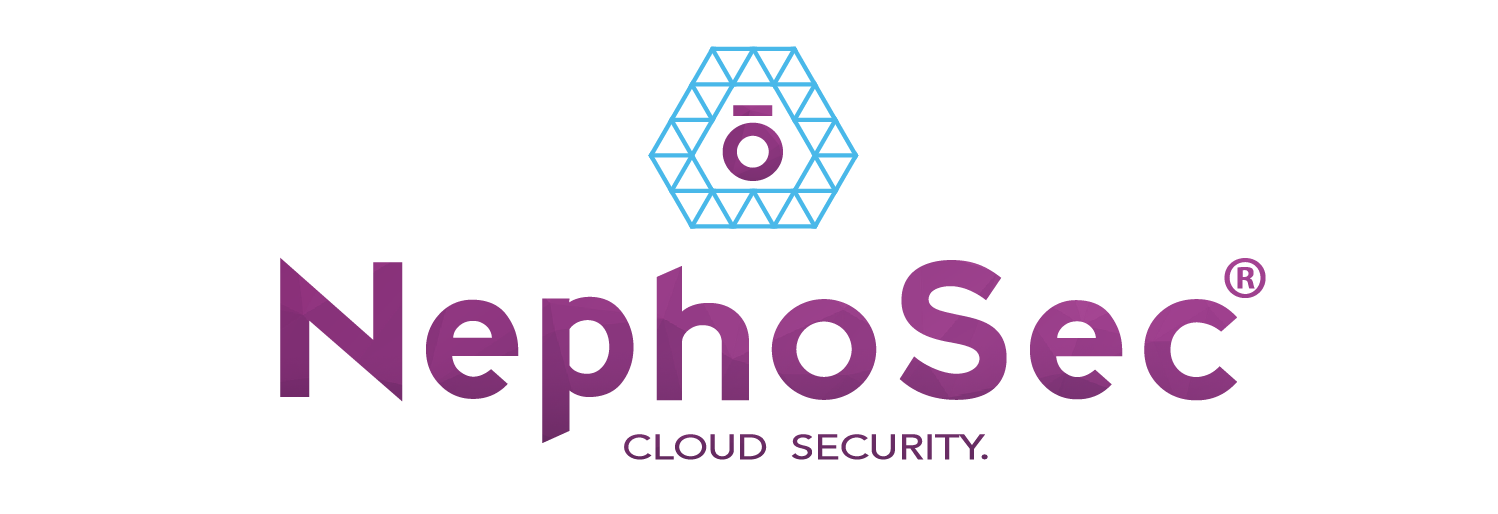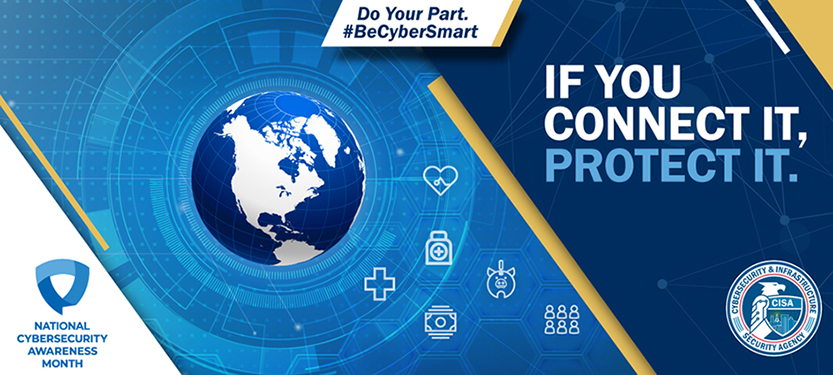19 Short Tips to Make Sure When You‘re Connected, You’re Protected
National Cybersecurity Awareness Month
INTERNET OF THINGS
With more connected “things” entering our homes and our workplaces each day, it is important that everyone knows how to secure their digital lives at work, at home and when traveling. Cars, appliances, fitness trackers and other wearables, lighting, healthcare, home security, and more all contain sensing devices that can talk to another machine and trigger other actions. These Internet-connected devices provide a level of convenience in our lives, but they require that we share more information than ever. The security of this information, and the security of these devices, is not always guaranteed. Once your device connects to the Internet, you and your device could potentially be vulnerable to all sorts of risks.
Simple Tips
- If You Connect IT, Protect IT. Whether it’s your computer, smartphone, game device, or other network devices, the best defense is to stay on top of things by updating to the latest security software, web browser, and operating systems. If you have the option to enable automatic updates to defend against the latest risks, turn it on. And, if you’re putting something into your device, such as a USB for an external hard drive, make sure your device’s security software scans for viruses and malware. Finally, protect your devices with antivirus software and be sure to periodically
- Backup your information. Back up any data that cannot be recreated such as photos or personal documents on your computer and mobile devices periodically to another device or cloud service in case your device is compromised and you have to reset it to factory settings.
- Keep up to date. Keep your software updated to the latest version available. Maintain your security settings to keep your information safe by turning on automatic updates so you don’t have to think about it, and set your security software to run regular scans.
- Secure your Wi-Fi Network. Your home’s wireless router is the primary entrance for cybercriminals to access all of your connected devices. Secure your Wi-Fi network and your digital devices by changing the factory-set default password and username. For more information about protecting your home network, check out the National Security Agency’s Cybersecurity Information page.
- Shake Up Your Password Protocol. Click here to a guide to Creating a Password.
- Double your login protection. Click here for a How-To-Guide For Multi-Factor Authentication.
- Stay protected while connected. Before you connect to any public wireless hotspot—such as at an airport, hotel, or café—be sure to confirm the name of the network and exact login procedures with appropriate staff to ensure that the network is legitimate. If you do use an unsecured public access point, practice good Internet hygiene by avoiding sensitive activities (e.g., banking) that require passwords or credit cards. Your personal hotspot is often a safer alternative to free Wi-Fi. Only use sites that begin with “https://” when online shopping or banking.
- Stop auto connecting. Some devices will automatically seek and connect to available wireless networks or Bluetooth devices. This instant connection opens the door for cyber criminals to remotely access your devices. Disable these features so that you actively choose when to connect to a safe network.
- Treat business information as personal information. Business information typically includes a mix of personal and proprietary data. While you may think of trade secrets and company credit accounts, it also includes employee personally identifiable information (PII) through tax forms and payroll accounts. Do not share PII with unknown parties or over unsecured networks.
- Guard your mobile devices. To prevent theft and unauthorized access or loss of sensitive information, never leave your equipment—including any USB or external storage devices—unattended in a public place. Keep your devices secured in taxis, at airports, on airplanes, and in your hotel room.
- Keep tabs on your apps. Most connected appliances, toys, and devices are supported by a mobile application. Your mobile device could be filled with suspicious apps running in the background or using default permissions you never realized you approved—gathering your personal information without your knowledge while also putting your identity and privacy at risk. Check your app permissions and use the “rule of least privilege” to delete what you don’t need or no longer use. Learn to just say “no” to privilege requests that don’t make sense. Only download apps from trusted vendors and sources.
- Social media is part of the fraud toolset. By searching Google and scanning your organization’s social media sites, cybercriminals can gather information about your partners and vendors, as well as human resources and financial departments. Employees should avoid oversharing on social media and should not conduct official business, exchange payment, or share PII on social media platforms. Read the Social Media Cybersecurity Tip Sheet for more information.
- Never click and tell. Limit what information you post on social media—from personal addresses to where you like to grab coffee. What many people don’t realize is that these seemingly random details are all that criminals need to know to target you, your loved ones, and your physical belongings—online and in the real world. Keep Social Security numbers, account numbers, and passwords private, as well as specific information about yourself, such as your full name, address, birthday, and even vacation plans. Disable location services that allow anyone to see where you are—and where you aren’t—at any given time.
- Play hard to get with strangers. Cyber criminals use phishing tactics, hoping to fool their victims. Click here to find more information about Identity Theft, Internet Scams & Phishing.
- Speak up if you’re uncomfortable. If a friend posts something about you that makes you uncomfortable or you think is inappropriate, let them know. Likewise, stay open-minded if a friend approaches you because something you’ve posted makes him or her uncomfortable. People have different tolerances for how much the world knows about them, and it is important to respect those differences. Don’t hesitate to report any instance of cyberbullying you see.
- Report suspicious or harassing activity. Work with your social media platform to report and possibly block harassing users. Report an incident if you’ve been a victim of cybercrime. Local and national authorities are ready to help you.
- Remember, there is no ‘Delete’ button on the Internet. Share with care, because even if you delete a post or picture from your profile seconds after posting it, chances are someone still saw it.
- Update your privacy settings. Set the privacy and security settings to your comfort level for information sharing. Disable geotagging, which allows anyone to see where you are—and where you aren’t—at any given time.
- Connect only with people you trust. While some social networks might seem safer for connecting because of the limited personal information shared through them, keep your connections to people you know and trust.
It only takes one time. Data breaches do not typically happen when a cybercriminal has hacked into an organization’s infrastructure. Many data breaches can be traced back to a single security vulnerability, phishing attempt, or instance of accidental exposure. Be wary of unusual sources, do not click on unknown links, and delete suspicious messages immediately.
Information provided by the Cybersecurity & Infrastructure Security Agency.
Schedule an appointment to talk with us about your cloud security needs at https://nephosec.com/talk-to-us/




